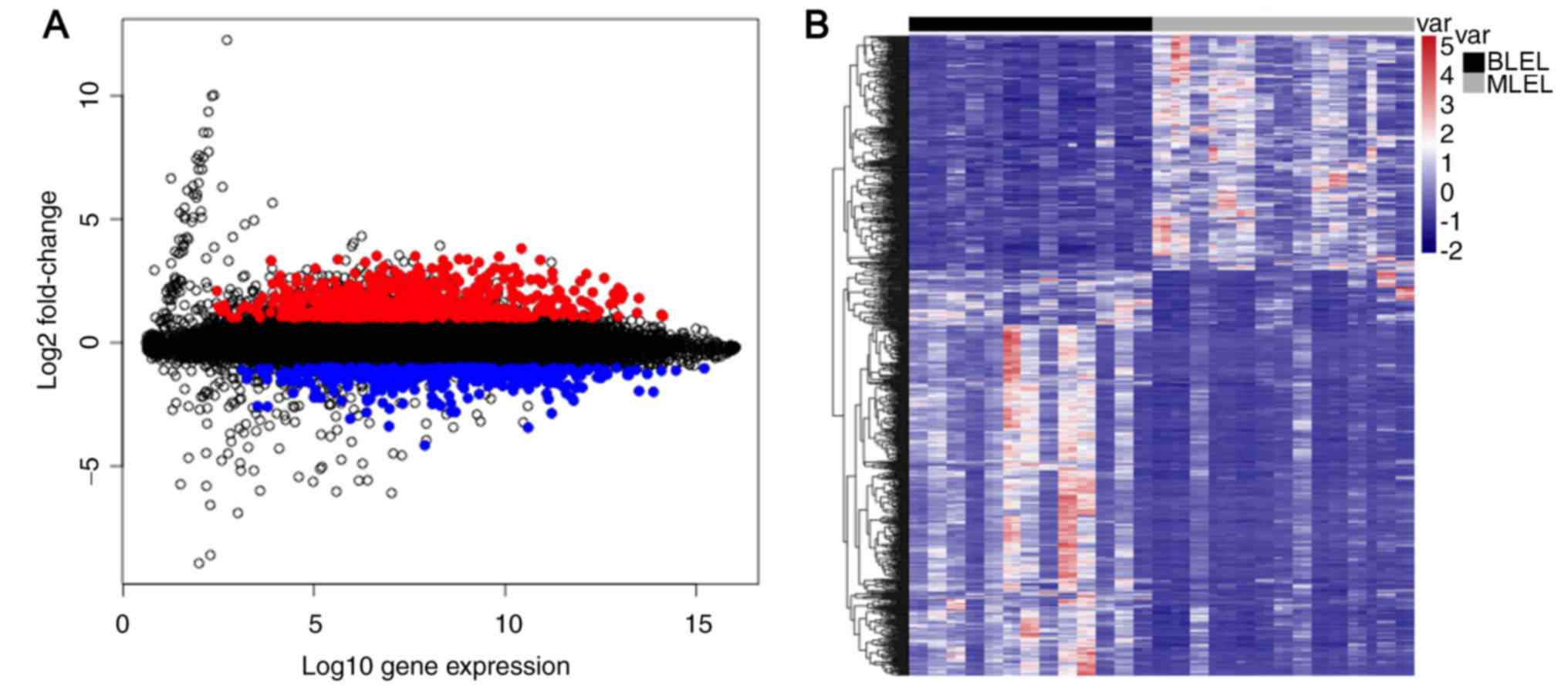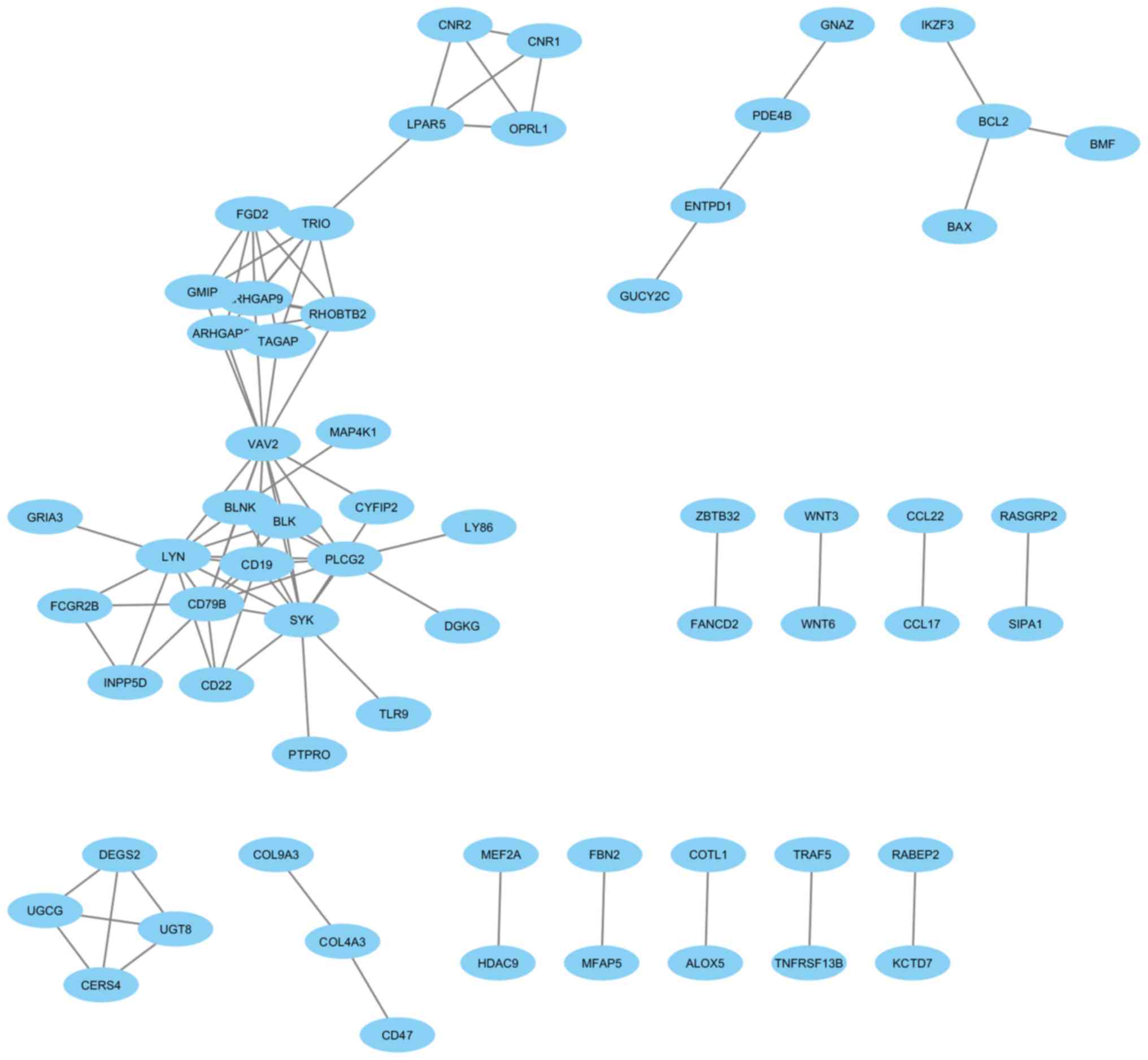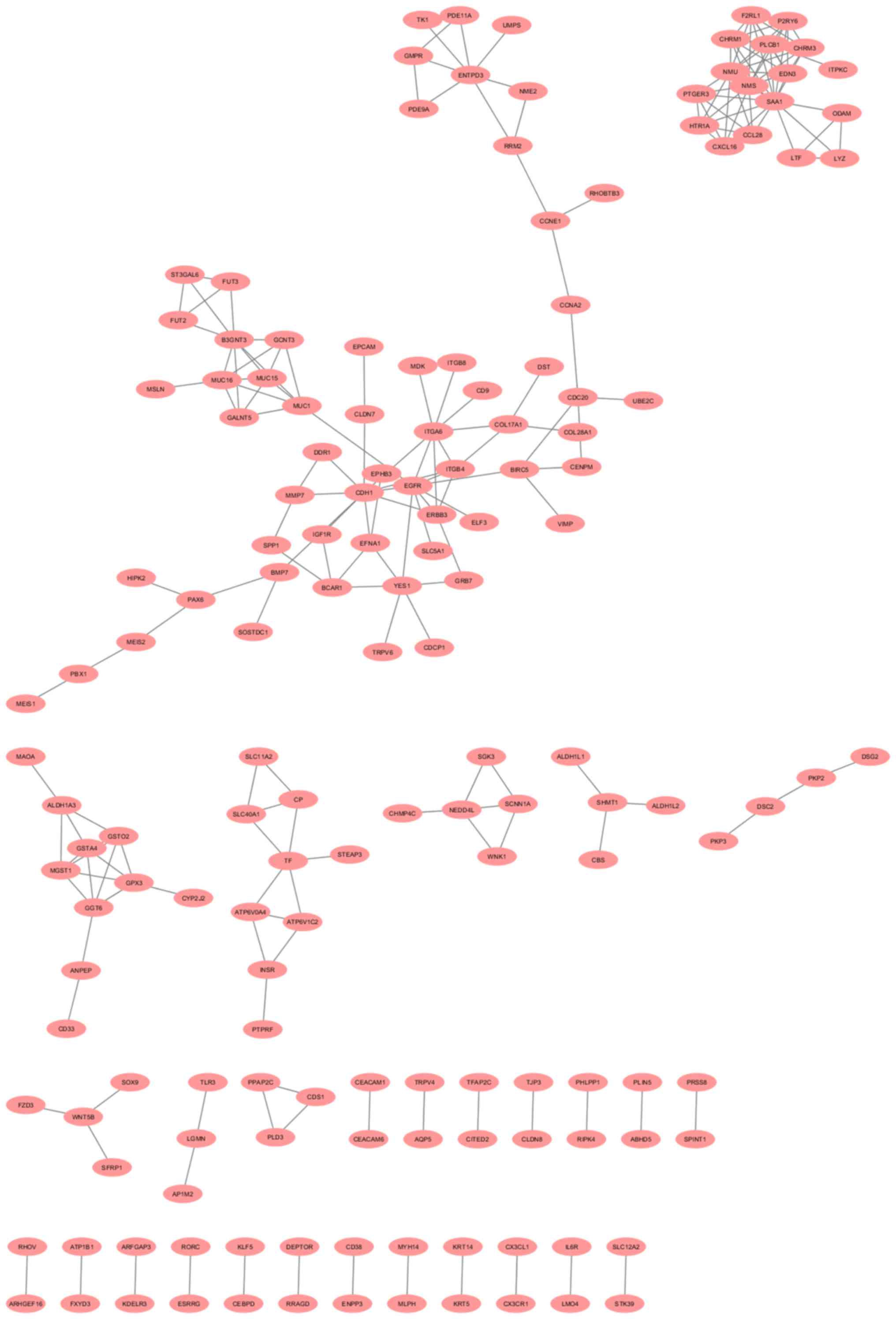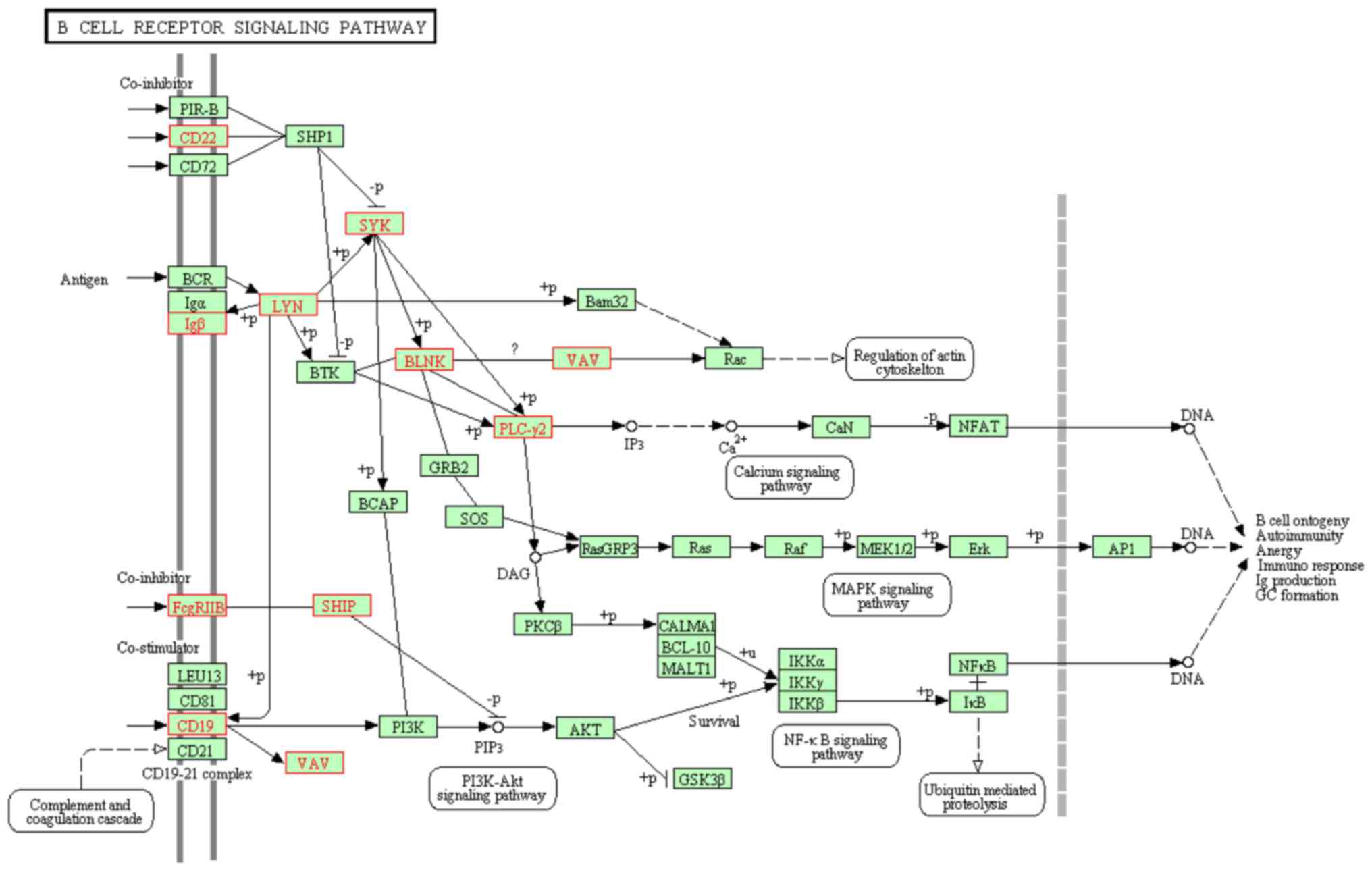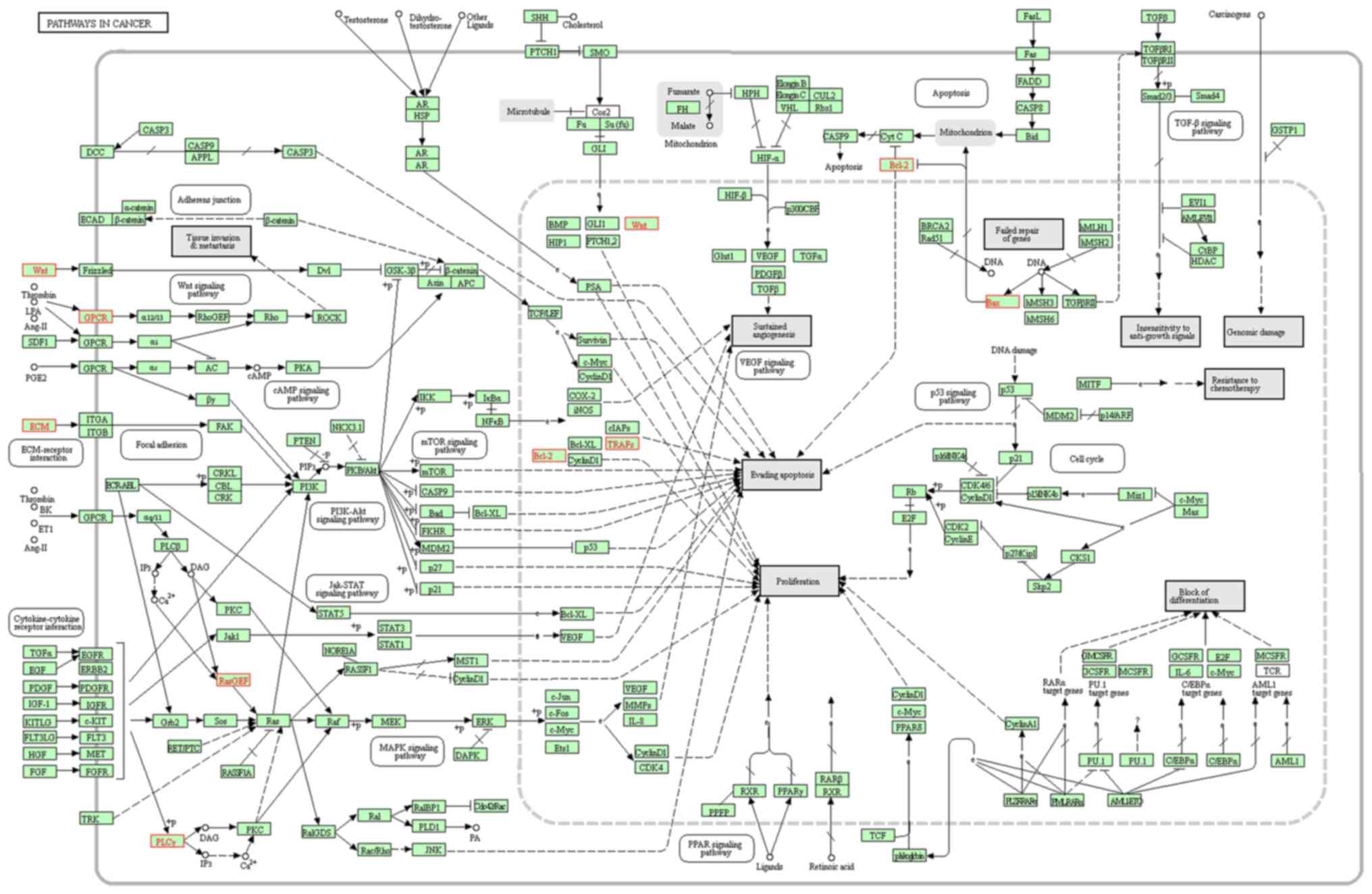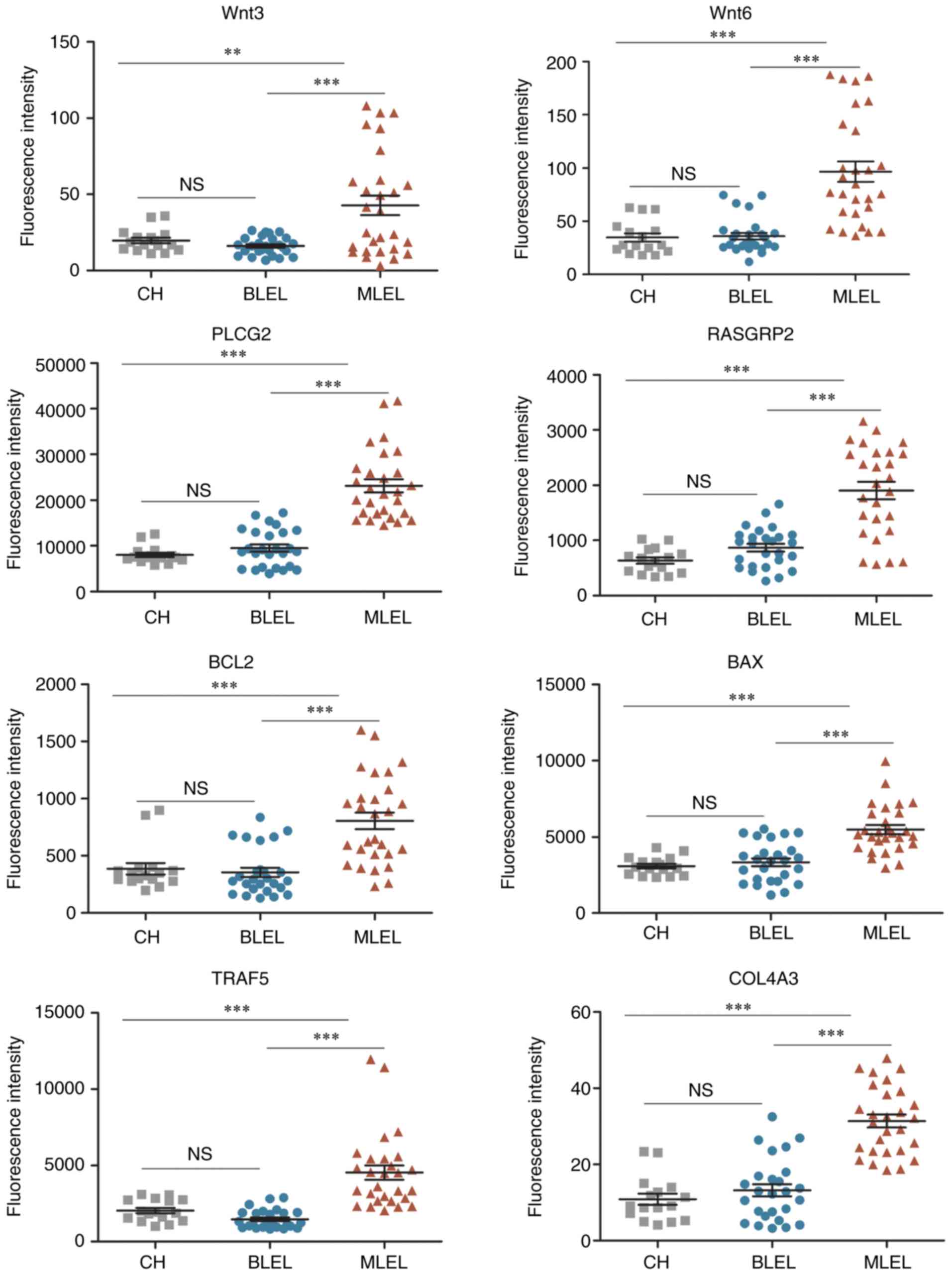Genes and pathways associated with the occurrence of malignancy in benign lymphoepithelial lesions
- Authors:
- Published online on: November 24, 2017 https://doi.org/10.3892/mmr.2017.8149
- Pages: 2177-2186
-
Copyright: © Adzavon et al. This is an open access article distributed under the terms of Creative Commons Attribution License.
Abstract
Introduction
Benign lymphoepithelial lesion (BLEL), also termed Mikulicz disease, is a systemic inflammatory disease of unknown origin. It is characterized by bilateral and persistent enlargement of lacrimal and salivary glands caused by infiltration of immunoglobulin (Ig)G4-positive plasma cells in the gland tissues (1,2). Initially assumed to be Sjögren's syndrome due to their histopathological similarities, Mikulicz disease has been established as a novel clinical entity. As a result of the elevated IgG4 concentration in serum in addition to the tumor-like swelling of involved organs and their variable degrees of fibrosis, Mikulicz disease has been included among the IgG4-associated diseases and recognized as immune-mediated conditions (1−3).
A number of cases and types of lymphoma have been reported in patients with BLEL however it is difficult to estimate the exact rate of lymphoma occurrence because of the low prevalence of malignant transformation. Nevertheless, a rate of 10.4% (11/106 patients) of malignancies was observed by Yamamoto et al (4) in 2012, 12% (2/17) by Sato et al (5) in 2008, and 14.3% (2/14) by Go et al (6) in 2012. Additionally, increasing numbers of studies highlighting evidence of malignant lymphoma among patients with Mikulicz disease and IgG4-associated disorders are accumulating. In 1971, Azzopardi et al (7) reported on five patients who exhibited signs of Mikulicz disease and malignant lymphoma at the same site; years later, three cases of possible malignant transformation of BLEL in human immunodeficiency virus-infected patients were reported (8); three other cases of malignant lymphoma, which arose in the parotid and the lacrimal glands of patients with BLEL, were reported by Sato et al (9) in 2002. More recently, marginal zone B cell lymphoma-mimicking IgG4-associated dacryoadenitis and sialoadenitis (10), or ocular adnexal marginal zone lymphomas arising from association with IgG4-associated disease, were reported (11). All these observations suggested that patients with BLEL, in addition to people suffering from IgG4-associated disease, exhibit a markedly increased risk for developing malignant lymphoma. Although, the risk of malignancy had been highlighted in BLEL and IgG4-associated disorders, the mechanisms underlying this malignant transformation remain unknown. The present study aimed to identify the molecular mechanisms, which may be involved in this malignant transformation by analyzing gene expression profiles between the two conditions.
Materials and methods
Sampling and microarray data processing
Following signed consent being obtained from all patients, tissue biopsies were obtained at Beijing Tongren Hospital between December 2011 and April 2012 from an adult population (36−78 years old, with a male:female ratio of 1:1.25) with the approval of the Local Ethics Committee of Beijing Tongren Hospital, Capital Medical University (Beijing, China). Biopsies of 14 fresh orbital tissues of malignant lymphoepithelial lesions (MLELs) composed of malignant B lymphoma patients (nine mucosa-associated lymphoid tissue B lymphomas, two large B lymphomas and three other B lymphomas) and 13 orbital tissues from patients with BLEL were subjected to Phalanx Human OneArray® Gene Expression Profiling (Phalanx Biotech Group, Hsinchu, Taiwan), according to the manufacturer's protocol. All the data were analyzed in duplicate. Following this, a robust multi-array average algorithm in the Affy package (Bioconductor; bioconductor.org/packages/release/bioc/html/affy.html) was used with R software (R version 3.3.0; www.r-project.org) for background correction, quantile normalization, and for summarization of the expression measure for each probe set in each array.
Identification and clustering of differentially expressed genes (DEGs)
A linear model for microarray data analysis provided by Bioconductor was fitted to the obtained gene expression matrix, which was used to identify the DEGs between BLEL and MLEL. The Benjamini-Hochberg procedure for multiple testing correction was used to control the false discovery rate (FDR) and significant DEGs were selected with |log2FC|>1 and FDR<0.01. Clustering analysis and heatmap creation for the DEGs were performed using dChip software version 2011.01 (12,13).
Protein-protein interaction (PPI) network construction for the DEGs
In living cells, molecular and biological processes are regulated by PPIs. PPIs are useful resources to identify novel pathways in order to gain a basic knowledge of diseases. Therefore, PPI were assessed for down- and upregulated DEGs with the online Search Tool for the Retrieval of Interacting Genes platform (version 10.0; https://string-db.org/). The highest confidence score ≥0.9 was used to predict links between proteins involved in the network and visualization of the interaction network was performed using Cytoscape (Cytoscape version 3.4.0; http://www.cytoscape.org/).
Functional annotation and pathway enrichment
Gene ontology (GO) functional annotation for biological process and the Kyoto Encyclopedia of Genes and Genomes (KEGG) pathways enrichment for the DEGs between MLEL and BLEL were performed using version 6.8 of the Database for Annotation, Visualization and Integrated Discovery (DAVID) online platform; https://david.ncifcrf.gov/. The Benjamini-Hochberg procedure for multiple testing correction was used to control the FDR. Significantly enriched GO terms and KEGG pathways were selected with an FDR<0.05.
Statistical analysis
Quantitative data were analyzed using GraphPad Prism v.5 (GraphPad Software, Inc., La Jolla, CA, USA) and are plotted as the mean ± standard error of the mean. For group comparisons, one-way analysis of variance with Bonferroni's multiple comparison test was used. P<0.05 was considered to indicate a statistically significant difference.
Results
Differential gene expression and expression pattern between BLEL and MLEL
Gene expression profiling between BLEL (n=13) and MLEL (n=14) biopsy tissues were performed for a total of 20,138 genes, and significant DEGs between the BLEL group and MLEL group were selected with |log2FC|>1 and FDR<0.01. A total of 1,002 genes (4.98%) were identified to be differentially expressed. Compared with the MLEL samples, 364 genes were downregulated and 638 genes upregulated in the BLEL group.
The results of the DEG visualization and selection, and the hierarchical clustering of the DEGs between the BLEL and MLEL groups, are exhibited for each replicate in Fig. 1.
PPI network analysis of the DEGs
The analysis of the PPIs for up- and downregulated DEGs with a confidence score ≥0.9 revealed that 62 proteins from the downregulated DEGs in the BLEL samples were engaged in the PPI networks, with a total of 91 interactions (Fig. 2). For the upregulated DEGs, 216 interactions were observed among the 156 proteins implicated in the PPI network (Fig. 3).
Functional annotation of DEGs in the PPI network
The downregulated DEGs in the BLEL group compared with the MLEL group were primarily increased in biological processes associated with immune signaling functions, including signal transduction, B cell activation and differentiation, response to stimulus and immune system process, while the upregulated DEGs were primarily associated with development-associated signaling processes, including cells and cellular components movement, response to stimulus, gland and tissues development, biological adhesion and cell migration (Tables I and II).
Table I.Top enriched biological processes for downregulated differential expressed genes in protein-protein interactions. |
Table II.Top enriched biological processes for upregulated differentially expressed genes in the protein-protein interaction network. |
Pathway enrichment of the DEGs in the PPI networks
KEGG pathways enrichment for the DEGs in the PPI network was performed using the online functional annotation tool DAVID. With a significant cut-off fixed at FDR<0.05, six KEGG pathways were significantly enriched for the downregulated DEGs and three for the upregulated DEGs (Table III). The downregulated DEGs in BLEL were associated with the B cell receptor (BCR) signaling pathway, transcription factor p65 signaling pathway, low affinity immunoglobulin γ Fc region receptor II-mediated phagocytosis, high affinity immunoglobulin ε receptor subunit γ signaling pathway, Epstein-Barr virus infection pathway and pathways in cancer. Glutathione metabolism, salivary secretion and the mineral absorption pathway were the only notable pathways associated with the upregulated DEGs. A map of the DEGs with the KEGG pathways for the BCR signaling pathway and pathways in cancer are exhibited in Figs. 4 and 5, respectively.
Table III.Enriched Kyoto Encyclopedia of Genes and Genomes pathways for up- and downregulated DEGs in the protein-protein interaction network. |
Prediction tools for the occurrence of malignancy in BLEL
In order to identify genes that could be used to predict malignant transformation in BLEL, the expression of the DEGs implicated in the pathways of cancer were compared to the expression in a control group composed of cavernous hemangioma samples. No significant difference in expression was observed for Wnt3, Wnt6, PLCG2, RASGRP2, Bcl−2, Bax, TRAF5 and COL4A3 between the control group and the BLEL group; however, the expression was significantly increased in the tissues of the malignant group (P<0.01; Fig. 6).
Discussion
For decades, gene expression profiling was widely used to highlight the underlying transcriptional programs and molecular mechanisms between normal and malignant conditions. It was used for class discovery and prediction, or for prediction of molecular markers, and for evaluation of the response to therapeutic compounds (14−19). In the present study, microarray-based gene expression profiling was utilized to identify genes and pathways which may be associated with the occurrence of malignant lymphoma in BLEL. Comparing the expression profiles of 20,138 genes between BLEL and MLEL, 1,002 (4.98%) DEGs were identified, among which 364 were downregulated and 638 upregulated in BLEL. In organisms, proteins interactions determine biological, molecular and cellular mechanisms which trigger the onset and progression of diseases (20); consequently, subsequent to the PPI analysis, the DEGs involved in this PPI network were used for functional enrichment of biological functions and for pathways analysis. The upregulated DEGs in the PPI network were mainly associated with the developmental processes of glands, tissues and organs, while the downregulated DEGs were associated with immune-associated signaling processes, confirming the implication of inflammation in the malignant occurrence as previously described (21). Pathway analysis identified BCR signaling and glutathione metabolism as the most enriched pathways involving down- and upregulated DEGs, respectively, in BLEL.
Although BCR signaling is important in B-cell activation and proliferation, evidence indicates that alterations to its signalosome components may directly or indirectly contribute to lymphomagenesis (22,23). Cluster of differentiation (CD) 79B overexpression was reported to induce protein kinase/mitogen-activated protein kinase 1 activation (24), decreased sensitivity to apoptosis in normal and B cell malignancies (25), and may promote lymphoma cell proliferation, while deregulation of the expression of CD19, a co-stimulator of BCR, may accelerate malignant transformation and/or disease severity (26−28). Additionally, emerging data from clinical trials indicates that interruption of BCR signaling by tyrosine-protein kinase SYK, phosphatidylinositol 3-kinase or tyrosine-protein kinase BTK inhibitors, has substantial anti-tumor activity in a number of B-cell malignancies. Although glutathione serves important roles in a number of biological functions, including antioxidant defense, nutrient metabolism and the regulation of cellular events, deregulation of its synthesis is recognized to contribute to pathogenesis. In addition, increased glutathione levels are exhibited in a number of tumors and have been demonstrated to confer tumor resistance (29). The results of the present study indicated that these cellular pathways and associated DEGs may serve an important role in the occurrence of malignancy in patients with BLEL.
The downregulated DEGs included a set of genes [collagen type IV α 3 chain (COL4A3), Wnt family member 3 (Wnt−3), lysophosphatidic acid receptor, BCL2 associated X apoptosis regulator (BAX), apoptosis regulator BCL2 (BCL2) phospholipase C γ 2, RAS guanyl releasing protein 2 (RASGRP2), Wnt−6 and TNF receptor associated factor 5] associated with pathways in cancer. COL4A3 is located on human chromosome 2q 36-q37 (30) and has a protein distribution limited to the basement membrane with tissue specificity. COL4A3 expression is correlated with pathogenesis in gastric cancer and its high expression is correlated with a poor prognosis in lung cancer (31,32). The Wnt−3/6 genes encode secreted signaling proteins, and have been implicated in oncogenesis and the regulation of cell fate. Studies of Wnt−3/6 expression suggested that they may serve an important role in carcinogenesis and their overexpression may be associated with the development of more aggressive tumors (33,34). BAX and BCL2 are important regulators of cancer cell survival. The protein encoded by BCL2 is an anti-apoptotic protein; its overexpression is correlated with tumor initiation, drug resistance and a poor outcome in patients with cancer (35,36). Although BAX is associated with apoptosis in a number of cell types, its heterodimerization with the anti-apoptotic protein BCL2 has been reported to suppress apoptosis (37) and to be correlated with poor clinical outcomes (38). RASGRP2 is a guanyl nucleotide exchange factor which, when malfunctioning, may contribute to blood malignancies. It increases cell viability and cell matrix adhesion via increased GTPase HRas expression and telomeric repeat-binding factor 2-interacting protein 1 activation (39).
The comparison of the expression of the DEGs implicated in the pathways of cancer with the expression in a control group composed of cavernous hemangioma samples demonstrated no differential expression between the control group and the BLEL group; however, their expression was increased in the tissues of the malignant group, suggesting that they may be considered to be prediction tool for the occurrence of malignancy in BLEL.
In conclusion, in the present study, a set of genes and pathways were analyzed which may be useful for an improved understanding of the molecular mechanisms underlying the occurrence of malignancy in BLEL; however, further investigation is required to confirm their exact roles in this process. In addition, the potential use of certain of the identified DEGs as a predictive tool of malignant transformation is suggested.
Acknowledgements
The present study was supported by the National Natural Science Foundation of China (grant nos. 81602408 and 81371052) and the China Postdoctoral Science Foundation funded project (grant no. 143096).
References
|
Yamamoto M, Takahashi H, Sugai S and Imai K: Clinical and pathological characteristics of Mikulicz's disease (IgG4-related plasmacytic exocrinopathy). Autoimmun Rev. 4:195–200. 2005. View Article : Google Scholar : PubMed/NCBI | |
|
Yamamoto M, Takahashi H, Ohara M, Suzuki C, Naishiro Y, Yamamoto H, Shinomura Y and Imai K: A new conceptualization for Mikulicz's disease as an IgG4-related plasmacytic disease. Mod Rheumatol. 16:335–340. 2006. View Article : Google Scholar : PubMed/NCBI | |
|
Stone JH, Zen Y and Deshpande V: IgG4-related disease. N Engl J Med. 366:539–551. 2012. View Article : Google Scholar : PubMed/NCBI | |
|
Yamamoto M, Takahashi H, Tabeya T, Suzuki C, Naishiro Y, Ishigami K, Yajima H, Shimizu Y, Obara M, Yamamoto H, et al: Risk of malignancies in IgG4-related disease. Mod Rheumatol. 22:414–418. 2012. View Article : Google Scholar : PubMed/NCBI | |
|
Sato Y, Ohshima K, Ichimura K, Sato M, Yamadori I, Tanaka T, Takata K, Morito T, Kondo E and Yoshino T: Ocular adnexal IgG4-related disease has uniform clinicopathology. Pathol Int. 58:465–470. 2008. View Article : Google Scholar : PubMed/NCBI | |
|
Go H, Kim JE, Kim YA, Chung HK, Khwarg SI, Kim CW and Jeon YK: Ocular adnexal IgG4-related disease: Comparative analysis with mucosa-associated lymphoid tissue lymphoma and other chronic inflammatory conditions. Histopathology. 60:296–312. 2012. View Article : Google Scholar : PubMed/NCBI | |
|
Azzopardi JG and Evans DJ: Malignant lymphoma of parotid associated with Mikulicz disease (benign lymphoepithelial lesion). J Clin Pathol. 24:744–752. 1971. View Article : Google Scholar : PubMed/NCBI | |
|
Del Bono V, Pretolesi F, Pontali E, Martinoli C, Bassetti M, Mazzarello G, Chiaramondia M, Derchi LE and Bassetti D: Possible malignant transformation of benign lymphoepithelial parotid lesions in human immunodeficiency virus-infected patients: Report of three cases. Clin Infect Dis. 30:947–949. 2000. View Article : Google Scholar : PubMed/NCBI | |
|
Sato K, Kawana M, Sato Y and Takahashi S: Malignant lymphoma in the head and neck associated with benign lymphoepithelial lesion of the parotid gland. Auris Nasus Larynx. 29:209–214. 2002. View Article : Google Scholar : PubMed/NCBI | |
|
Ohta M, Moriyama M, Goto Y, Kawano S, Tanaka A, Maehara T, Furukawa S, Hayashida JN, Kiyoshima T, Shimizu M, et al: A case of marginal zone B cell lymphoma mimicking IgG4-related dacryoadenitis and sialoadenitis. World J Surg Oncol. 13:672015. View Article : Google Scholar : PubMed/NCBI | |
|
Ohno K, Sato Y, Ohshima K, Takata K, Miyata-Takata T, Takeuchi M, Gion Y, Tachibana T, Orita Y, Ito T, et al: A subset of ocular adnexal marginal zone lymphomas may arise in association with IgG4-related disease. Sci Rep. 5:135392015. View Article : Google Scholar : PubMed/NCBI | |
|
Li C and Hung Wong W: Model-based analysis of oligonucleotide arrays: Model validation, design issues and standard error application. Genome Biol. 2:Research00322001. View Article : Google Scholar : PubMed/NCBI | |
|
Lv J, Zhu B, Zhang L, Xie Q and Zhuo W: Detection and screening of small molecule agents for overcoming Sorafenib resistance of hepatocellular carcinoma: A bioinformatics study. Int J Clin Exp Med. 8:2317–2325. 2015.PubMed/NCBI | |
|
Golub TR, Slonim DK, Tamayo P, Huard C, Gaasenbeek M, Mesirov JP, Coller H, Loh ML, Downing JR, Caligiuri MA, et al: Molecular classification of cancer: Class discovery and class prediction by gene expression monitoring. Science. 286:531–537. 1999. View Article : Google Scholar : PubMed/NCBI | |
|
Bullinger L, Dohner K, Bair E, Fröhling S, Schlenk RF, Tibshirani R, Döhner H and Pollack JR: Use of gene-expression profiling to identify prognostic subclasses in adult acute myeloid leukemia. N Engl J Med. 350:1605–1616. 2004. View Article : Google Scholar : PubMed/NCBI | |
|
Valk PJ, Verhaak RG, Beijen MA, Erpelinck CA, Barjesteh van Waalwijk van Doorn-Khosrovani S, Boer JM, Beverloo HB, Moorhouse MJ, van der Spek PJ, Löwenberg B and Delwel R: Prognostically useful gene-expression profiles in acute myeloid leukemia. N Engl J Med. 350:1617–1628. 2004. View Article : Google Scholar : PubMed/NCBI | |
|
Raponi M, Lancet JE, Fan H, Dossey L, Lee G, Gojo I, Feldman EJ, Gotlib J, Morris LE, Greenberg PL, et al: A 2-gene classifier for predicting response to the farnesy ltransferase inhibitor tipifarnib in acute myeloid leukemia. Blood. 111:2589–2596. 2008. View Article : Google Scholar : PubMed/NCBI | |
|
Kohlmann A, Bullinger L, Thiede C, Schaich M, Schnittger S, Döhner K, Dugas M, Klein HU, Döhner H, Ehninger G and Haferlach T: Gene expression profiling in AML with normal karyotype can predict mutations for molecular markers and allows novel insights into perturbed biological pathways. Leukemia. 24:1216–1220. 2010. View Article : Google Scholar : PubMed/NCBI | |
|
Theilgaard-Mönch K, Boultwood J, Ferrari S, Giannopoulos K, Hernandez-Rivas JM, Kohlmann A, Morgan M, Porse B, Tagliafico E, Zwaan CM, et al: Gene expression profiling in MDS and AML: Potential and future avenues. Leukemia. 25:909–920. 2011. View Article : Google Scholar : PubMed/NCBI | |
|
Safari-Alighiarloo N, Taghizadeh M, Rezaei-Tavirani M, Goliaei B and Peyvandi AA: Protein-protein interaction networks (PPI) and complex diseases. Gastroenterol Hepatol Bed Bench. 7:17–31. 2014.PubMed/NCBI | |
|
Elinav E, Nowarski R, Thaiss CA, Hu B, Jin C and Flavell RA: Inflammation-induced cancer: Crosstalk between tumours, immune cells and microorganisms. Nat Rev Cancer. 13:759–771. 2013. View Article : Google Scholar : PubMed/NCBI | |
|
Niemann CU and Wiestner A: B-cell receptor signaling as a driver of lymphoma development and evolution. Semin Cancer Biol. 23:410–421. 2013. View Article : Google Scholar : PubMed/NCBI | |
|
Refaeli Y, Young RM, Turner BC, Duda J, Field KA and Bishop JM: The B cell antigen receptor and overexpression of MYC can cooperate in the genesis of B cell lymphomas. PLoS Biol. 6:e1522008. View Article : Google Scholar : PubMed/NCBI | |
|
Kim JH, Kim WS, Ryu K, Kim SJ and Park C: CD79B limits response of diffuse large B cell lymphoma to ibrutinib. Leuk Lymphoma. 57:1413–1422. 2016. View Article : Google Scholar : PubMed/NCBI | |
|
Cragg MS, Chan HT, Fox MD, Tutt A, Smith A, Oscier DG, Hamblin TJ and Glennie MJ: The alternative transcript of CD79b is overexpressed in B-CLL and inhibits signaling for apoptosis. Blood. 100:3068–3076. 2002. View Article : Google Scholar : PubMed/NCBI | |
|
Chung EY, Psathas JN, Yu D, Li Y, Weiss MJ and Thomas-Tikhonenko A: CD19 is a major B cell receptor-independent activator of MYC-driven B-lymphomagenesis. J Clin Invest. 122:2257–2266. 2012. View Article : Google Scholar : PubMed/NCBI | |
|
Li X, Ding Y, Zi M, Sun L, Zhang W, Chen S and Xu Y: CD19, from bench to bedside. Immunol lett. 183:86–95. 2017. View Article : Google Scholar : PubMed/NCBI | |
|
Poe JC, Minard-Colin V, Kountikov EI, Haas KM and Tedder TF: A c-Myc and surface CD19 signaling amplification loop promotes B cell lymphoma development and progression in mice. J Immunol. 189:2318–2325. 2012. View Article : Google Scholar : PubMed/NCBI | |
|
Lu SC: Regulation of glutathione synthesis. Mol Aspects Med. 30:42–59. 2009. View Article : Google Scholar : PubMed/NCBI | |
|
Morrison KE, Mariyama M, Yang-Feng TL and Reeders ST: Sequence and localization of a partial cDNA encoding the human alpha 3 chain of type IV collagen. Am J Hum Genet. 49:545–554. 1991.PubMed/NCBI | |
|
Nie XC, Wang JP, Zhu W, Xu XY, Xing YN, Yu M, Liu YP, Takano Y and Zheng HC: COL4A3 expression correlates with pathogenesis, pathologic behaviors and prognosis of gastric carcinomas. Hum Pathol. 44:77–86. 2013. View Article : Google Scholar : PubMed/NCBI | |
|
Jiang CP, Wu BH, Chen SP, Fu MY, Yang M, Liu F and Wang BQ: High COL4A3 expression correlates with poor prognosis after cisplatin plus gemcitabine chemotherapy in non-small cell lung cancer. Tumour Biol. 34:415–420. 2013. View Article : Google Scholar : PubMed/NCBI | |
|
Nakashima N, Liu D, Huang CL, Ueno M, Zhang X and Yokomise H: Wnt3 gene expression promotes tumor progression in non-small cell lung cancer. Lung cancer. 76:228–234. 2012. View Article : Google Scholar : PubMed/NCBI | |
|
Zhang L, Yuan G, Fang Y, Qiu M, Lin J, Sun J and Yang D: Increased WNT6 expression in tumor cells predicts unfavorable survival in esophageal squamous cell carcinoma patients. Int J Clin Exp Pathol. 8:11421–11427. 2015.PubMed/NCBI | |
|
Kaluzki I, Hrgovic I, Hailemariam-Jahn T, Doll M, Kleemann J, Valesky EM, Kippenberger S, Kaufmann R, Zoeller N and Meissner M: Dimethylfumarate inhibits melanoma cell proliferation via p21 and p53 induction and bcl-2 and cyclin B1 downregulation. Tumour Biol. 37:13627–13635. 2016. View Article : Google Scholar : PubMed/NCBI | |
|
Bajwa N, Liao C and Nikolovska-Coleska Z: Inhibitors of the anti-apoptotic Bcl-2 proteins: A patent review. Expert Opin Ther Pat. 22:37–55. 2012. View Article : Google Scholar : PubMed/NCBI | |
|
Yin XM, Oltvai ZN and Korsmeyer SJ: BH1 and BH2 domains of Bcl-2 are required for inhibition of apoptosis and heterodimerization with Bax. Nature. 369:321–323. 1994. View Article : Google Scholar : PubMed/NCBI | |
|
Mühlbeier DF, Saddi VA, de Paula ÉC, Cunha IW, Fregnani JH, Barbosa MA and Manoel WJ: Prognostic Significance of Apoptosis-related Markers in Patients With Soft-Tissue Sarcomas of Extremities. Appl Immunohistochem Mol Morphol. 24:268–274. 2016. View Article : Google Scholar : PubMed/NCBI | |
|
Takino J, Nagamine K and Hori T: Ras guanyl nucleotide releasing protein 2 affects cell viability and cell-matrix adhesion in ECV304 endothelial cells. Cell Adh Migr. 7:262–266. 2013. View Article : Google Scholar : PubMed/NCBI |



